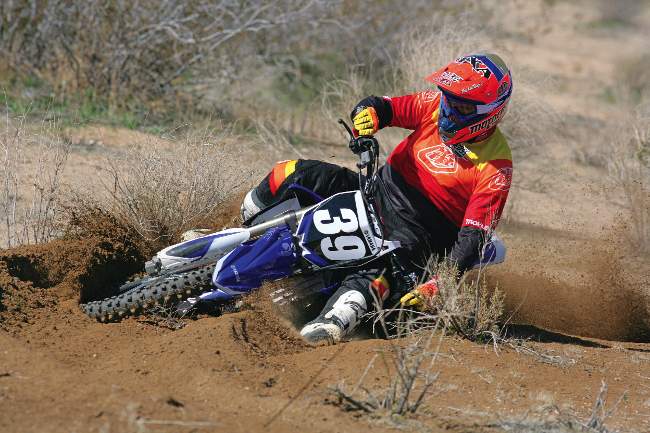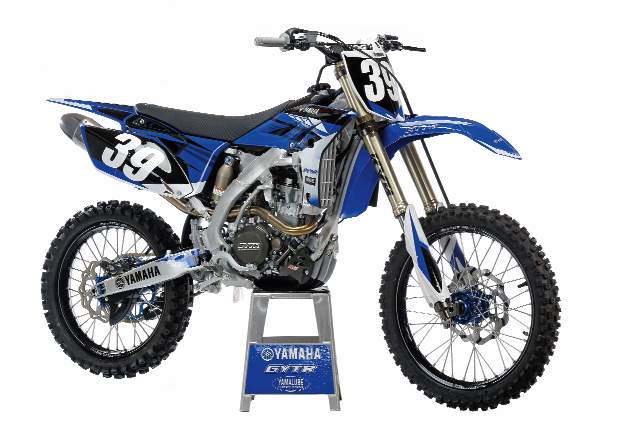WE RIDE GYTR’S 2010 YAMAHA YZ250F PROJECT BIKE

Most people take for granted the ability to go down to their local Honda, Kawasaki, Suzuki or Yamaha dealer and buy a motocross bike. It wasn’t always this way. In the good old days, if you wanted to race flat track, scrambles, Hare and Hounds, desert races or motocross on a Japanese-built bike, you had to buy a dual-purpose bike and modify it for your discipline.
As offroad riding became increasingly popular, manufacturers went looking for ways to satisfy the growing dirt bike racing market. The most famous of these stopgap solutions was the Yamaha GYT kit. GYT stood for Genuine Yamaha Tuning and was pronounced “git.” The first offroad GYT kit was built for the 1968 Yamaha DT-1 trail bike. It consisted of a chrome-plated cylinder, high-combustion head, single-ring piston, 30mm Mikuni carb and an exhaust pipe. It pumped out 10 more horsepower than the mild-mannered DT-1.
Yamaha would later extend the GYT domain to cover the 1970 Yamaha RT360 and 125cc AT1, but when the first YZ125 was introduced in 1974, the GYT kit was phased out. Why did Yamaha stop making aftermarket hop-up kits? That’s simple. Yamaha’s marketing men reasoned that it would insult their all-new YZ motocross line to offer parts to make it better. After all, if the consumer thought that the manufacturer could make better parts, he might wonder why they weren’t on the bike he bought in the first place.

This is the modern day GYTR kit. Usually project bikes are bombarded with aftermarket hop-ups that partially obscure the OEM logo.
Although the GYT kit lay dormant for decades, the four P’s of successful marketing (product, price, place and promotion) tempted Yamaha to bring the idea back. With a successful network of dealers and race teams in place, Yamaha felt that they had the perfect launching pad to sell a special line of aftermarket products. Their logic was unassailable?since companies like FMF and Pro Circuit were making millions selling products for Yamaha race bikes, Yamaha figured that they would be crazy not to do the same. The opportunity was too good to pass up, so Yamaha reestablished the GYT kit concept under a new name, GYTR (Genuine Yamaha Technology & Research) and positioned it under Yamaha’s alphabet distributing arm YPAD (Yamaha Parts & Accessory Division).
The theory behind GYTR products is that no one knows Yamahas better than Yamaha. That is where the MXA wrecking crew and the GYTR division agree. When we discussed the idea of a fully modified, 2010 GYTR Yamaha YZ250F project bike, we quickly realized it would be all about the engine. Although GYTR sells lots of fluff, foof and goodies in their catalog, the meat-and-potatoes of any 250 four-stroke is the engine. And, without pulling any punches, the 2010 Yamaha YZ250F powerplant feels like it was created shortly after Fred Flintstone’s feet got tired. Our challenge to the GYTR boys was to build us a competitive 2010 Yamaha YZ250F.
 |
| The GYTR head is CNC machined, ported and comes preassembled with cams and parts installed. |
SHOP TALK: BENCH WRENCHING
The engine work is what makes the GYTR bike special. And the hop-up parts are for sale to the public, but with a catch. The catch is that you can’t buy the parts separately. You must buy the cylinder head fully pre-assembled. Part of the reason for this is that even though GYTR starts with the same blank heads as the production bikes, they CNC machine them instead of hand porting them. This way, GYTR feels that they can achieve optimal flow of fuel and air through the head. The process also ensures that all the GYTR heads are identical and to spec. The bottom line is that the Yamaha GYTR race head costs $2245.95. For comparison, buying all the same stock parts, unassembled, would cost $1750.00.
Technically, the head is an OEM part. As a rule of thumb, OEM parts are built to tighter tolerances and perform more reliably than some aftermarket parts. Yamaha subjects their equipment to harsh durability tests, GYTR stuff included. The testing process must be good, because our 2010 YZ’s have been extremely reliable after months of abuse.
Equally notable is what is not in the GYTR engine kit. For this project, the Yamaha guys decided to pass on the high-compression piston. It would have required high-octane race gas, and with the continuing upward spiral of race gas prices, GYTR felt it would be better to build a pump gas engine.
Our project bike was constantly undergoing changes. Every time we thought that the Yamaha testing department was going to give us the final engine spec, they would delay. Why? They were constantly testing different cam profiles. Then, once they got the profile with the most improved mid and top (something that the stock 2010 YZ250F lacks), they needed to optimize the valve springs and setup.
Equally notable is what is not in the GYTR engine kit. For this project, the Yamaha guys decided to pass on the high-compression piston. It would have required high-octane race gas, and with the continuing upward spiral of race gas prices, GYTR felt it would be better to build a pump gas engine (as a practical measure to appeal to a larger cross section of racers).
Further modifying the power delivery is a GYTR exhaust system. The 98 dB muffler is designed for easy repacking and can be brought down to the AMA-legal 94 dB level with an insert (at the cost of some power).

GYTR is trying to use its access to Yamaha dealerships to jump-start is previously dead hop-up business.
MXA did avail itself of other parts in the GYTR catalog. Our test bike had a CNC-machined clutch (including basket, inner hub, pressure plate and clutch cover). In charge of stopping was a 270mm Braking Batfly oversized rotor kit (which comes with Braking pads and a GYTR braided steel brake line). For ergos, the bike had a One Industries gripper seat and Tag bars with Slim grips. We also added GYTR pivoting levers, radiator braces, a carbon fiber glide plate and a carbon fiber rear caliper guard.
The final step in creating our GYTR project bike was making it look the part. This included a bevy of anodized parts that were were not completely devoid of practicality?like a blue timing plug, blue oil fill cap, easy-to-adjust fuel screw, shiny axle blocks (with big, visible alignment marks), blue rear sprocket, gold 520 GMXL chain and a plastic chain guide. The finishing touches were black Excel Takasago rims and a One Industries graphics kit.
 |
| The engine wasn’t the only part of the bike with launching power. The Braking Batfly can launch you over the bars. |
TEST RIDE: NO THANKS, I’LL SHIFT LATER
MXA tests dozens of project bikes every year, and we know better than anyone that a little TLC goes a long way when it comes to the final setup of a project bike. It’s great to start with a brand-new motorcycle, but careful break-in and a modicum of mechanical prep ensure a good first impression. And it wasn’t hard to see how hard the Yamaha testing department was working on our test bike. Every week, when we thought we would be getting our completed GYTR YZ250F, we would find a bevy of Yamaha R&D guys out testing some doodad, cam profile or gizmo on our test bike. Although we couldn’t get our hands on the bike until it was ready, we were able to chase it around Glen Helen on a weekly basis. This turned out to be a valuable way to determine how much progress GYTR was making on the powerband.
Finally, Yamaha decided that all of the GYTR parts were tuned to the nth degree. We arranged to meet them at the Race Town track in Adelanto, California, for the first shakedown cruise. With a stock 2010 Yamaha YZ250 for comparison, the MXA test riders began switching back and forth between the stocker and the GYTR kit bike. We had the foresight to have Yamaha leave the suspension stock on both bikes so that no outside influences would taint our feel for the powerband.
The first thing we confirmed was what we already knew about the stock YZ250F:
(1) It has awesome low to mid power.
(2) It has virtually no top-end power at all. On the other hand, the GYTR YZ250F had all the high-rpm power that a pro could ever crave.
The GYTR bike was smooth off the bottom compared to the stocker’s hit, but it didn’t sacrifice too much power. As the rpm spun into the midrange, the GYTR bike really started to shine. Where the stocker needs to be short-shifted, the GYTR bike pulled long and strong. MXA testers didn’t have to shift until right before hitting the rev limiter. We were glad Yamaha decided not to go with a high-compression piston. On most 250F’s, the high-compression has a tendency to make the bike feel as though it chugs up the powerband and then chugs down under decelleration?it takes away the free-revving character. The stock YZ250F and GYTR YZ250 both have a little of this “heavy” characteristic anyway?even without the high-compression piston.

Most MXA test riders don’t like the stock 2010 YZ250F powerband because it is too short and too low in the powerband. The GYTR mods fixes the flaws.
After the shakedown cruise (with Yamaha personnel in tow), we jettisoned those guys and started racing the bike every weekend. It is when we are racing that we make the most useful discoveries?not play racing on a Thursday. MXA test riders found the best performance off the starting line with a large throttle opening, some clutch slipping and a violent twist once the rear wheel hooked up. The extra over-rev on top was a phenomenal improvement over the stock YZ250F. And, test riders who were most familiar with the 2010 YZ250F thought it gave the bike a new personality. On the stocker, it felt like we were shifting every 50 feet?the GYTR engine gave us the ability to carry speed farther and hold a gear longer.
Yamaha’s setup time paid off, because we only made three minor changes. First, we went a couple clicks firmer and lowered the forks a few millimeters to gain a little stability. Second, we lowered the rear brake pedal slightly to help prevent locking up the rear brakes entering turns. Our last modification was to add Tag’s Slim grips. These grips have a little raised ridge that hides the safety wire groove just inside of the main flange. It bothered a couple of testers, so we trimmed it off with a pair of dykes.
 |
| The GYTR-tuned exhaust is affordable because MXA complained about the MSRP of the 450 pipe. You’re welcome. |
CONCLUSION: THE GAVEL IS DOWN
Without any suspension modifications, the overall package of the GYTR bike was impressive. Mid and top are what the YZ250F needs, and GYTR’s cylinder head provides. This isn’t a cheap mod, but if you’re a serious racer, the GYTR preassembled unit is a no-brainer. As for the allotment of other GYTR treasures, we wouldn’t necessarily spring for the whole kit-and-kaboodle on our own bikes, but the package made for a fun and fast race bike.





Comments are closed.